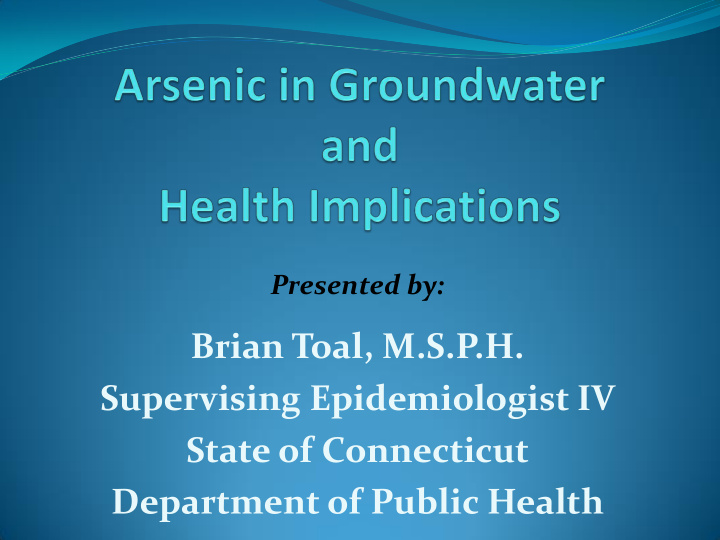



Presented by: Brian Toal, M.S.P.H. Supervising Epidemiologist IV State of Connecticut Department of Public Health
Arsenic (As) Naturally occurring metal Found in soil, bedrock, groundwater, surface water, air, food Odorless and tasteless Found in organic and nonorganic forms Used in industry, farming, pressure treated wood
Arsenic in Groundwater Found worldwide, famously in Bangladesh (62% >10 ppb – Max. = 3,700 ppb Average 1-2 ppb or micrograms per liter 10% of wells in New Hampshire greater than federal standard – 10 ppb Some levels up to 200 ppb CT data not easily available, levels up to 40 ppb in N.E. CT
Arsenic in United States Groundwater
As Exposures Diet is largest source 10-50 µg/day Most of that is less toxic organic arsenic (60%) Seafood is big source – almost all organic Drinking Water up to 5 µg/day average Soil and air contribute less Children may get more from soil and decks
As Health Effects - #1 As is a human carcinogen: bladder, lung, skin Non-cancer effects – skin, heart, immune, nervous system, GI system These effects are chronic, take many years to develop
As Health Effects - #2 Acute As poisoning not likely to occur at levels found in well water Effects depend on dose and duration time Human cancer seen at levels over 150 ppb May affect brain development in utero exposure and during childhood
Medical Testing for As Not generally recommended Unreliable and hard to interpret Background levels in all of us No medical use – will not direct treatment Simplest answer is to test drinking water
Testing for As In Water Certified labs on DPH Web Site Compare to federal standard of 10 ppb Once every 5 years
Treatment for As Many good options – consult well treatment specialist No single device for all wells – depends on water chemistry Reverse Osmosis, metal oxide filters, ion exchange systems National Sanitation Foundation Can treat at point of use – kitchen tap,little absorption in showering and bathing
Recommend
More recommend